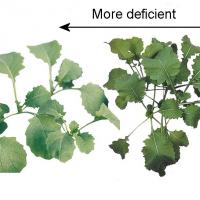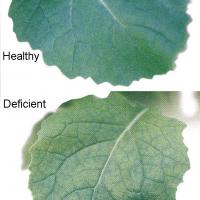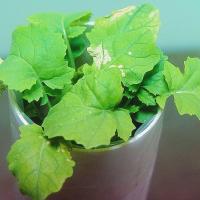Diagnosing copper deficiency in canola
Copper is essential for pollen formation and has a role in formation of chlorophyll and cell walls. Deficiency can cause grain abortion and high yield losses.
What to look for
- Symptoms can be difficult to diagnose in the field.
- Smaller paler sometimes wilted plants with worse symptoms on lighter soil or newly limed areas and better on old windrows.
Paddock
- Deficient plants tend to wilt easily, are smaller and paler green.
- Interveinal paleness caused by numerous yellow specks develops between veins of older leaves that progresses until the whole plant appears pale green.
- Fully expanded leaves are thinner, disc shaped with fewer marginal serrations. The growing point dies on severely deficient plants.
Plant
What else could it be
| Condition | Similarities | Differences |
|---|---|---|
| Diagnosing molybdenum deficiency in canola | Smaller plants with pale leaves; interveinal chlorosis | Molybdenum deficient leaves have scorched edges; copper deficient plants have numerous yellow specks develops between veins of older leaves that progresses until the whole plant appears pale green |
| Diagnosing zinc deficiency in canola | Smaller plants with pale leaves; interveinal chlorosis | Copper deficient plants have numerous yellow specks develops between veins of older leaves that progresses until the whole plant appears pale green |
Where does it occur?

Soil type

Dry conditions
- With the exception of loam or clay salmon gum or York-gum soils, most soils required copper and zinc when cleared for agriculture.
- Canola has a lower copper requirement than wheat or barley.
- Copper is readily available in the soil for many years, but is relatively immobile and can become unavailable to crops in dry soil particularly in no-till systems.
- Copper deficiency can be induced by heavy liming; increased plant nitrogen status; use of zinc fertiliser; and where root growth is restricted.
Management strategies

Spraying foliar
- Foliar spray (only effective in the current season) or drilled copper fertiliser with the seed.
- Copper foliar sprays are not effective after flowering as sufficient copper is required pre-flowering for fertile pollen development.
- As copper is immobile in the soil top dressing is of little value, only being effective when the topsoil is wet.
- Mixing copper throughout the topsoil makes it more likely that roots can intercept the nutrient because soil at depth stays moist longer.
- In long term notill paddocks fertiliser use via in-furrow application or seed treatment reduces the risk of plant roots not being able to obtain enough copper in dry seasons.
- Copper seed treatment is insufficient for plant requirement in the current season.
How can it be monitored?

Soil test
- DTPA copper soil test provide a rough guide for copper status.
- Whole-top plant test provides a rough guide if paired good/ poor samples are taken, but this should be confirmed with a youngest emerged blade (YEB) test.
- Whole shoots of young plants below about 4mg/kg (seedling) to 2.2mg/kg (rosette) and YEB levels below about 3mg/kg indicate copper deficiency.
Where to go for expert help
Page last updated: Wednesday, 12 July 2017 - 12:23pm





